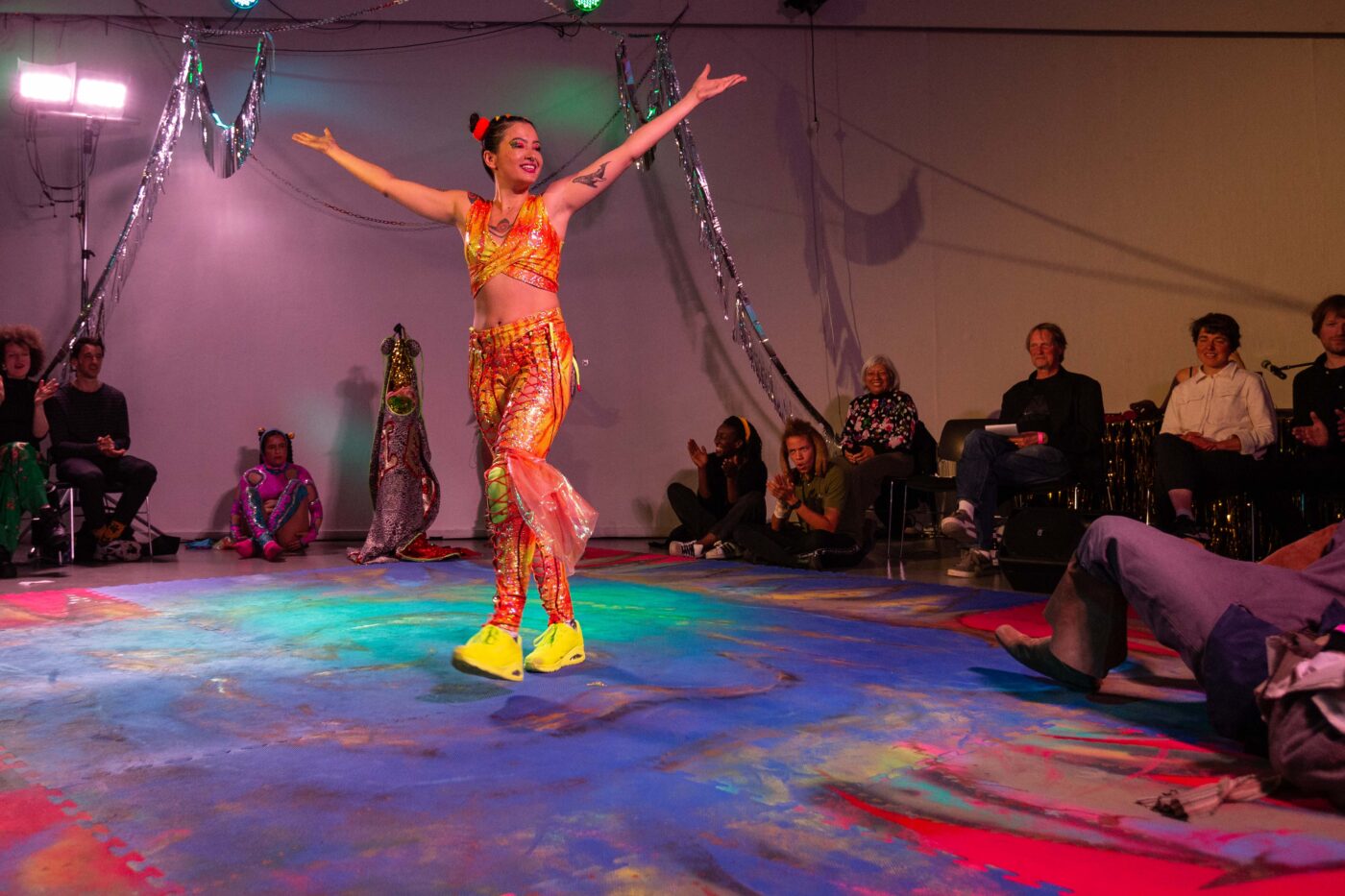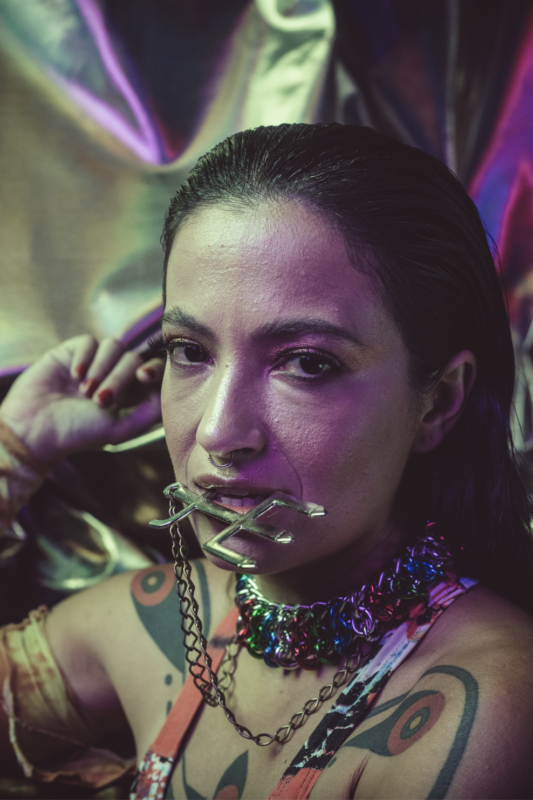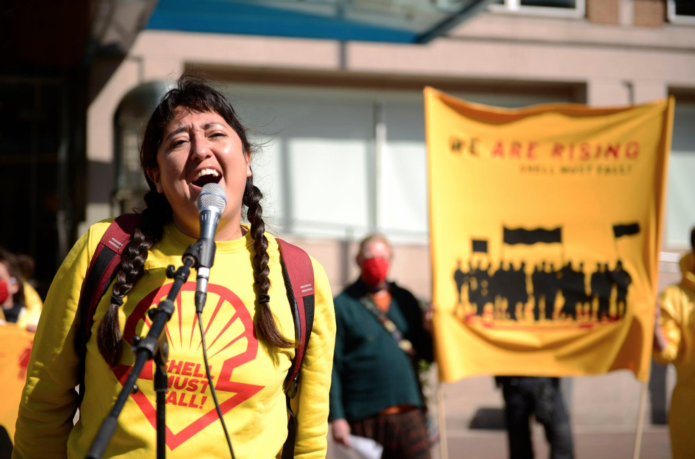 The Goldfish Bleeding in a Sea of Sharks - Wrestling Club, Thais di Marco, FLAM#9, photo by David Cenzer
The Goldfish Bleeding in a Sea of Sharks - Wrestling Club, Thais di Marco, FLAM#9, photo by David Cenzer Interview: Thais Di Marco on Neoliberalism and the Arts
Living in the Netherlands many have grown up into neoliberal ideology and the longer you swim in the water the harder it is to see it. Neoliberalism has often been theorised and criticised by white men in the sphere of economics.
In the following interview, artist and activist Chihiro Geuzebroek discusses neoliberalism in the cultural sphere and art creation with choreographer/artist Thais di Marco, who was born in Brazil and has lived in the Netherlands for the past six years.
Chihiro Geuzebroek: In the performance you made The Goldfish Bleeding in a Sea of Sharks you are the goldfish. What makes you the Goldfish?
Thais di Marco: My elders called me this when I was very young because I was challenging powers that were much bigger than me without the capacity to win. There is a myth I received when I was very young which says that I would be a warrior. I am a daughter of Yansã, the goddess of the storm and who is fearless. They used to say this saying “you are acting like a goldfish bleeding in a sea of sharks”, to warn me about danger: it means that someone is advising you to stop. It is a warning you are putting yourself in the path of danger. You are going to attract more sharks with the smell of your blood.
CG: As an artist, you have radical politics around no-auditioning, against contracts and other industry-imposed norms. The language of the piece doesn’t necessarily express that. I see a language of parody of spectacle. I wonder what you expect people to see who come to see the performance.
TdM: I am studying and practicing the dramaturgy of Lucha Libre which is a social practice of enacting social conflicts. The performance is a citation of a form that has been created through centuries. In the show you won’t see the resolution of anything big. I think it is impossible with the working conditions we have as independent producers, working with community based centers, confronting the inequalities of the art market, to embrace the vast span of political questions. So I use different devices, like the series of panels, for us to have this conversation. What people will see in the show is this using the device of performing arts.
CG: So, diving into neoliberalism. How would you describe the difference between liberalism and neoliberalism?
TdM: Those are two different historical moments that are actualizing an ideology about private property and how to deal with the resources of the planet; those material and immaterial belongings of the Earth. When neoliberalism comes with the idea that the state needs to protect the market it is a perversion of what a democratic government should be. Not that I believe in national states, I see them as genocidal machines. But in neoliberalism, I see an update of technologies to protect the same groups that dominate the resources of the planet.
CG: So how does that show up in the workfield of the artist?
TdM: First, we have to have a debate on the social role of art. To clarify where I stand, I believe that art is a practice of archiving the future, things that don’t exist yet. To make visible what is invisible and yet extremely present. It is an exercise of emerge-ncy and shaping. And this can inform the political project and ideologies to come. So, historically, we see art movements becoming political projects. It is what we call the mangue in Portuguese – the place in the river where the crabs live and where fish lay their eggs. Lots of fetuses from there go to the river, the sea and the land.
Every People has a mythological history that says who they are, where they come from, what they are here for and what they believe in, their destiny. What I find sad about neoliberalism (and capitalism at large) is that it says the world is going to end. It is a suicidal story. Neoliberalism is a perversion, an apocalyptic cyber form of Christian capitalism.
CG: Wow. I love all the images you are conjuring up here. You are a magician. I am talking to a rhizomatic mind magician! Do you mean this regime has no service to the planet and its idea of the market is creating death and desolation?
TdM: Yes, its hierarchies of life are violent. In the archive of neoliberal mythology for example, there is this idea of “talent”. Talent is some form of fascist essentialist ableist mythology that you supposedly can express some essence through art and that serves to socialize people to profitable labor. If you historicize this – look at museums, exhibitions – how funds are distributed mostly to white heterosexual cis-male people, then it creates the idea that they are better essentially. So when you confront art institutions: Why in your program are the most artists male? Then the answer is too often: talent. There is never a clear policy. It is clear that talent is used to maintain exclusionary selection processes.
CG: To historicise that: how was it before neoliberalism? Is it not something that the idea of ‘talent’ has been weaponised already before the neoliberalism art sector?
TdM: I want to distinguish between art and the art market. And when we talk about the art market, we talk about work that has been commodified and possible to integrate in a neoliberal system of the market.
CG: So art is like a future-fertiliser and the art market like a future-pesticide?
TdM: Right.
CG: So moving from market to marketing, how do you reflect on marketing as a modality artists are expected to be fluent in?
TdM: Marketing is a very lazy, target-oriented trick. It is another perverted cyber form. We are talking about the knowledge on aesthetics that was created by art practices to contribute to this planet being used by big data analytics for profit. Knowledge about colour, shapes, rhythm, position and dimension, weaponised in some algorithm to manipulate and monetise us. Marketing as it is now, is a radical neoliberal form of art.
CG: And how do you see the difference between marketing and promotion? Because promotion is way older than neoliberalism. While marketing is relatively new, if you read Naomi Klein’s book No Logo for example, it is very new to extend promotion to identity through branding. So, how do you distinguish?
TdM: I am not sure if there is a difference for me. I do not come from alluring or expansive traditions of being Growth oriented and I find “number policies” de-humanizing. In Candomblé culture, we do not have the aim of getting more people to do anything. Because we are doing things for the planet, for anyone to enter and to leave when they want. All you need to know is the rhythm and the elements of the earth, we do it for ourselves. For me “number politics” has its past in crusades.
CG: So, how did you feel the logic of neoliberalism manifested in art education?
TdM: I see ostensive neoliberal training in art schools. I see, for example, dance techniques trying to erase the history of the bodies, especially the ones who are racialized or come from non canonical European art practices, that often are not even called art. Socio-political experiences leave visible traces in the way we move. Most of the art education training tries to hide the histories of any oppressed body. You are building a body that is sellable and intelligent and that will make choices to “win”. And you need your body to look a certain way to be able to represent all those values. I feel like contemporary art is often based on erasing history. Erasing traces through the promise of innovation.
CG: How did you negotiate that pressure?
TdM: I don’t think I’m in a position for negotiation as I was never part of a canonical decision-making space in an art school to try making contractual contributions. The times I tried, I heard that despite having years of teaching practice in a narco-dominated zone, having dealt with youngsters in all sorts of conditions, I was not suitable for the context here. I think in my art practice, I oppose the erasure of oppressed histories and I try to commit mistakes and contradictions as responsible as I can, as I’m inside of the market. What I do is, I work with techniques that rich people don’t like. I constantly challenge what is good and bad in contemporary art. With that, I challenge unclear undemocratic concepts around ‘good’ art.
CG: For people who come here to learn about neoliberalism and the arts and what to do about it — what to do about it?
TdM: I would like to speak with people that were born into forms of neoliberal arts and only know that way. I like to always ask why – like Paulo Freire’s teachings: why am I reproducing this? Do I believe in that? Do I know the structural consequences of what I produce? Do I know why I like what I like? Why do I reference this artist, and not someone else? Some people get really angry because it requires a lot of work to be reflective about our own choices and open the possibility of making others together. A lot of work. But when I’m working as a director, I see an explosion of possibility. There is always the horizon of events for new politics. It is sad that the assimilation of labor structures kills our explosion of potential.
I read in the booklet We Will Not Cancel Us (AK Press, 2020) something like: “When we can’t distinguish our comrades from our opponents, we lose our capacity to generate belonging”. I don’t have a manual. My people are dying. We are getting smaller and smaller. I come from a post-apocalyptic cosmology that is not hegemonic and yet assimilated by the modern world, both Roma and Candomblé. The end of the world happened already. I am afraid neoliberal socialization includes a training of subjectification that prevents people from seeing the impacts of their deeds and of the ideologies they reproduce. A socialization process that prevents accountability. In the context of the Netherlands I am always very impressed how the artists are disempowered by patronizing ideas: “I wish the production houses would choose me, that they produce for me, make cultural politics for me, book all my tours, I wish the curator to see my talent, that I can just demand structural models from others, so I can express my “freedom” in an artwork”.
I am not saying we need to do everything ourselves. That is also a very neoliberal entrepreneurial idea. But what is going to change the system, in my view, are long term social movements and social pressure, not demanding and copying obsolete neoliberal ideas such as career, professionalism, diplomas, competition, exceptionalism and egocentrism, forcing those against each other.
CG: So your emphasis is on disruption?
TdM: Well yes, disruption and prophecy!
This interview has been published in the lead up to the panel Neoliberalism and the Art/ist taking place at Framer Framed on 30 June 2022.
- VICE - Glitters en gracieus geweld tijdens een meerdaags worstelfestijn
- Bodies in Resistance - Conversation with Thais di Marco
Links
Burgerschap / Kunst en Activisme / Politiek Klimaat /
Agenda
Performance: 0UT SPOK3N B$Cht%% door Thais Di Marco
Solo performance-experiment door kunstenaar Thais Di Marco, ontvanger van de 3Package Deal van het Amsterdams Fonds voor de Kunst
Discussie: Neoliberalism and the Art/ist
Met Priya Swamy & Teresea Borasino, gemodereerd door Chihiro Geuzebroek
Netwerk

Thais di Marco
Artist and choreographer
